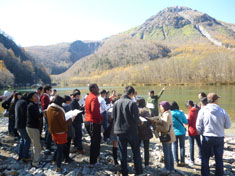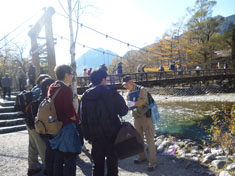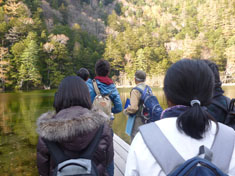Report
FOLENS Seminar October 2011: Kamikochi/ Matsumoto Field Trip – Nature, History, Tourism, Agriculture, and Research
Student's Reports:![]() Antonio dos Santos,
Antonio dos Santos,![]() Aung Zaw Oo,
Aung Zaw Oo,![]() Chihiro Yamaguchi,
Chihiro Yamaguchi,
![]() Co Thi Kinh,
Co Thi Kinh,
![]() Maki Ito,
Maki Ito,
![]() Mohammad Sahin Polan,
Mohammad Sahin Polan,![]() Rai Kumar BANJARA,
Rai Kumar BANJARA,![]() Rina Kurumisawa,
Rina Kurumisawa,
![]() Naotaka Shuto,
Naotaka Shuto,![]() VO THI MINH TAM,
VO THI MINH TAM,![]() Yeo Bee Geok(Maybelline),
Yeo Bee Geok(Maybelline),
![]() Yuta Numajiri,
Yuta Numajiri,
=========================================================================================
 |
 |
 |
The FOLENS Seminar in October 2011 was held on the 28th and 29th, as a two-day trip to Kamikochi and Matsumoto in Nagano Prefecture.
This was a joint program with “Practical Exercise for International Environmental
and
Agricultural Research”, an official subject of Department of International Environmenta
and Agriculturall
Research(IEAS). A total of 50 participants joined the trip, including 17
students of FOLENS, 19 students of IEAS,
and 14 faculty members of IEAS and FOLENS.
Day 1: When we finally arrived in Taisho Pond of Kamikochi after a four-hour ride on a bus
from Tokyo, the breathtaking beauty of mountains with the blue sky background welcomed us.
There, Assoc. Prof. Furuichi of FOLENS delivered a mini-lecture on the geographical features
of the surrounding area, with a particular focus on Mt. Yakedake, referring to a topographical map
distributed.
Assist. Prof. Ozaki of FOLENS also explained the increase of tourists to Kamikochi and
its impacts on the natural environment. Visitors to Kamikochi have rapidly increased since 1985 and
currently its number is around 1.5 million per year. This has led to environmental issues such as
increased trash, invasion of alien species, and pollution due to increased traffic.
After enjoying a walk and a lunch in the amazing scenery, we departed to three-hour trekking between
Kappa Bridge and Myojin Pond. We divided us into small groups, and each group was accompanied by
a local nature park guide volunteer. They explained Kamikochi from various aspects such as flora and
fauna, geography, history, culture, and so on. Both the students and faculty were so impressed by
extensive knowledge, passion, and energy of the guides, some of whom were even over 80 years old.
Thanks to them, we learned various faces of beautiful Kamikochi, not visible when you just pass by. (SN)
Day2: After spending cold but glorious morning in the camping site in the foot of the Mt. Hodaka,
we moved to Matumoto City, then to Azumino City.
Three stops were made there:
(1) Silk-worm memorial park,
(2) the Matsumoto Castle and
(3) a Wasabi farm.
Dr. Hamano, a retired Professor of the IEAS Department, made a field lecture on the silk warm
agriculture/industry in Japan. Silk worm industry used to be an important industry for Japan in the
late 19th century through the middle of 20th century, and Matusmoto was a center of research on
silk warm production and silk textile industry.
The Matsumoto Castle is one of the four castles designated as the national treasure.
We observed the castle with kind and detailed explanation by international volunteer guides (Alps Language Service Association: ALSA), and could comprehend structure, history, small good stories,
etc. of the castle. Azumino, a neighbor city of Matsumoto to the north, is famous for its abundant
spring water resource which is recharged in the Northern Japan Alps.
Some farmers are making use of the precious resource for Wasabi farming, which requires ample
clear water running throughout a year. We visited a Wasabi farm which is opened to the public
for observation. The fields for growing Wasabi are covered by pebbles and cobbles, not by soil, and
heights of every plantation line in the fields are precisely set for clear spring water to flow steadily.
This 2-day field visit was an opportunity to learn the nature of the Northern Japan Alps, one of the
most distinguished natural environments of Japan, and impacts to the precious nature of human
activities including sightseeing purposes. Three visits in Matusumoto and Azumino also provided a
chance to be familiar with various aspects of a major city in the foot of the Northern Japan Alps.
The field visit also had a role of introduction for new FOLENS students and student networks were
undoubtedly expanded and affirmed. (TF)
Program:
Friday, 28 October
7:00 Departing TUAT Fuchu Campus
11:00 Arriving in Kamikochi, Nagano Prefecture
http://www.kamikochi.or.jp/english/index.php
Lecture & guided trekking (Taisho Pond, Meijin Pond)
- Natural environment (geography, vegetation and wildlife)
- Eco-tourism and its environmental impact
16:00 Arriving in accommodation/ Dinner preparation
17:30 Dinner/ Party
Saturday, 29 October
7:00 Breakfast
8:30 Departing accommodation
9:30 Monument for the innovation of sericulture
http://hamadayori.com/hass-col/agri/SangyoKakusin.htm
10:00 Matsumoto Castle (English guide available)
12:30 Lunch at Daio Wasabi Farm
http://www.daiowasabi.co.jp/
- Filming site of "Dreams" (a movie by Director Akira Kurosawa)
15:00 Departing Daio Wasabi Farm
19:00 Arriving in Fuchu